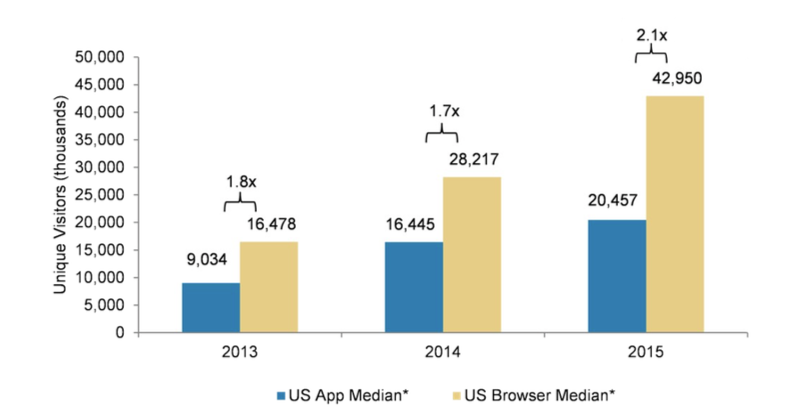Wait, what? Mobile browser traffic is 2X bigger than app traffic, and growing faster, by John Koetsier of VentureBeat
Adam Rifkin stashed this in Mobile Web!
Source: http://venturebeat.com/2015/09/25/wait-what...
Found via Marc Andreessen who calls the Mobile Web "fleek": https://twitter.com/pmarca/status/647760756860063745
Stashed in: Mobile!, Software!, Marc Andreessen, Awesome, Web Browsers, Active Users, Google, MOBILE, Mobile Apps, Mobile Ads!, Mobile Dev!, Active Users
Good Writeup by John:
Mobile browser traffic is actually twice that of mobile app traffic, according to a just-released Morgan Stanley report that rates Google’s stock as a buy. This appears to fly in the face of recent, strong, and repeated evidence that the app is winning, capturing 80-90 percent of our time on mobile.
Actually, both are right.
Using comScore data, Morgan Stanley says the web is winning.
On the one hand, that’s great news for those who are facing higher and higher mobile user acquisition costs as premium in-app inventory dries up. And it’s great news for brand marketers, who are continually looking for ways to reach new customers.
But it’s also potentially confusing, given that a report released this week by comScore itself said that 87 percent of all time spent on mobile in the U.S. was spent in mobile apps. Not only are we spending almost 9 out of every 10 minutes in apps, but that number has grown 90 percent since 2013, while mobile web time has grown only 53 percent in the same period.
So comScore says the app is winning.
Both are right, of course.
The problem is terminology and the exact focus of each study. Morgan Stanley’s study is focused on unique visitors — calling it, somewhat misleadingly, “traffic” — while comScore’s report is focused on actual user time spent.
Those are vastly different measures, and it’s no shock that they present vastly different pictures of what’s happening in mobile. Mobile users spend massive numbers of hours in Subway Surfer or Game of War, blowing 80 percent of their time in just five favorite apps, while they might also visit 10 or 15 mobile web sites of companies that they’re checking out, and spend just a few moments on each. Mobile “traffic” — read unique visitors — are up on mobile web, but mobile time is also up on apps.
The questions proliferate: Why is this happening, what’s best, and what matters most? And, what should brands, companies, and media properties do?
The answer is pretty simple: Deepest engagement for the longest period of time happens in apps, so apps matter, and they matter desperately for brands who want to connect to customers. But since, as we’ve seen in our research, apps-per-smartphone users is maxxing out at an average of 50-60, and no-one besides Robert Scoble is going to install an app for each company, service, or site he or she interacts with, your mobile web experience has to be good, and it has to be strong.
What you hope is that the experience with your entire company is so good, and the service or value you provide is so impressive, and the benefits to your app are so clear … that casual browsers turn into mobile app users.
Which, Morgan Stanley acknowleges, matters. Only two of the top 30 U.S. retailers drove more than 50 percent of their visits via app — Amazon and Walmart.
That’s good, the authors acknowledge:
“This is positive for these two players as over time we believe larger app audiences can lead to lower long-term customer acquisition costs, stickier customer bases, and a greater share of consumer wallets,” the report states.”
No doubt about it. Getting a much-coveted position on the 3-foot device (never more than three feet from your body) is gold for brands and gold for companies. Not only will you get a chance to serve those clients better, you’ll understand them, their habits, and their needs much better. At least, if you’re doing the right things to learn from them.
One other caveat about the Morgan Stanley report: It referenced only the top 50 mobile properties in the U.S., not the entire web/mobile space. Only 12 of those top 50 mobile properties have larger app than mobile web audiences, and those are mainly from tech companies like Google — which has four of the top 12 — and Snapchat, Pinterest, Yahoo, Netflix, and Pandora.












11:08 AM Sep 26 2015